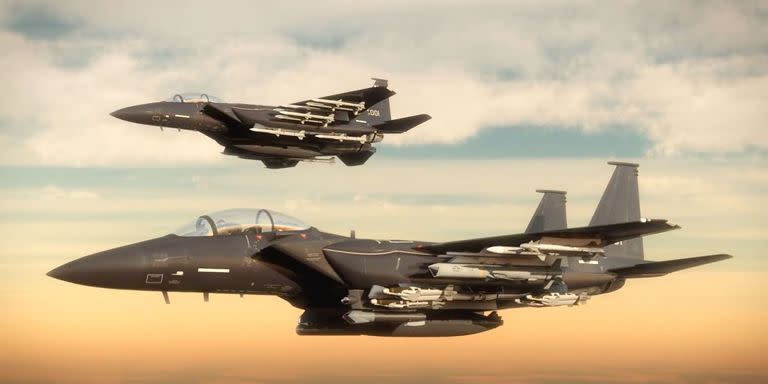After Nearly 20 Years, the Air Force Will Fly Brand New F-15s

The U.S. Air Force is ordering its first new F-15 Eagle fighter jets in nearly 20 years.
The new jets feature fully modern avionics, thanks to Boeing's contracts providing new Eagles to other countries over the past two decades.
A major selling point of the new F-15EX is the fighter's ability to carry up to 22 air-to-air missiles, far more than the F-35.
After nearly twenty years, the U.S. Air Force is buying brand new Eagles to fly alongside the F-22 and F-35 fighters stealth fighters. Despite a lack of stealth there’s one thing the F-15 can do that the new fighters can’t: carry lots and lots of missiles. The new F-15EX will likely serve as a flying magazine for stealthy fighters, teaming up against adversaries to shoot them down in large numbers.
Comebacks are rare in the world of warplanes. The relentless pace of technological advancement, coupled with the slowness of government bureaucracy, generally means that a fighter jet is often obsolete as soon as it rolls off the production line. One fighter jet that has destroyed this conventional wisdom is the F-15 Eagle.
The F-15 Eagle first flew in the 1970s, and by the late 1970s achieved operational status with the U.S. Air Force. In the late 1980s, the pure air-to-air fighter was modified to strike targets on the ground, earning it the multi-role description. The U.S. Air Force bought the last of these F-15E jets in 2001, back when Boeing could brag that the jets would receive “active matrix liquid crystal displays,” or LCD displays, instead of old fashioned cathode ray tube displays also found on big, boxy television sets.
The end of American purchases of the F-15 didn’t spell the end of the line for the Eagle. Boeing continued to develop the plane, adding the latest technology for clients including Israel, South Korea, Qatar, and Saudi Arabia. In 2018 Boeing pitched a new version, the F-15EX, not as a replacement for the F-35 Joint Strike Fighter but to operate alongside it.
The F-15EX features all the latest technology, integration already paid for by foreign clients, plus the ability to carry 22 AIM-9X Sidewinder and AMRAAM medium range air-to-air missiles. Air Force Magazine reports other improvements include a “substantially more powerful mission computer, new cockpit displays, a digital backbone, and the Eagle Passive Active Warning Survivability System (EPAWSS)—an electronic warfare and threat identification system.”
The F-35 Joint Strike Fighter, on the other hand, can only carry four AMRAAM missiles in an internal weapons bay, a result of its need to fly without missiles and other equipment hanging off its wings to preserve its anti-radar stealth profile. The F-15 doesn’t have any internal bays but has lots of missile racks. The F-35 and F-15EX will likely fly in pairs, with the F-35 quietly detecting enemy fighters while the F-15EX services them with air-to-air missiles.
The Air Force is preparing to buy two F-15EXs. It wanted to buy eight fighters as a down payment on a force of at least 72, but Congress refused to buy the full eight—at least for now anyway. Congress has agreed to fund another six after the service provides a report outlining how it intends to buy the entire fleet.
Source: Air Force Magazine.
You Might Also Like


